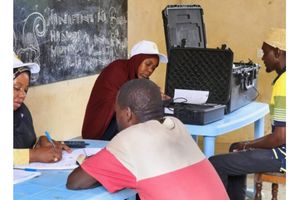How mobile phones are driving digital financial services growth

Tanzania has registered 3.2 million more mobile money subscribers in the first quarter of 2022.
What you need to know:
- The gadgets have enhanced the inclusion of unbanked Tanzanians, with 94.3 percent of the adult population now accessing financial services through mobile phones
Arusha. Mobile phones have radically transformed the financial services landscape in the country and for the better.
The gadgets have greatly enhanced the inclusion of unbanked segments of the population in formal financial services.
As of March this year, the adult population using financial services through mobile phones reached 94.3 percent.
There were 55.4 million mobile phone subscribers in Tanzania in March this year while the number of the adult population accessing financial services through mobile phones reached 80.8 percent.
In 2021,the value of mobile money transactions to total Gross Domestic Product (GDP) increased to 66 percent from 40 percent in 2013.
The number of mobile money subscribers was 35.3 million in December last year, equivalent to 61 percent of the total population but jumped to 55.4million in March.
“This means the digital financial services in Tanzania has continued to surge,” said the Bank of Tanzania governor, Prof Florens Luoga.
He said this here yesterday during the African financial inclusion roundtable for leaders from the financial sector from across the continent.
The meeting discussed how innovations in digital finance have expanded financial services in areas that traditional banks have not reached.
Prof Luoga said although Tanzanians embraced mobile money transfers for the past 15 years, BoT took a deliberate move to the effect during Covid.19.
“We decided to promote cashless transactions during Covid-19 pandemic and enhance mobile money transaction limits,” he pointed out.
Other contributing factors were implementation of new Fintech products for merchants and small businesses such as payment by phone (Lipa Namba).
Others are Quick Response (QR) Code solutions through Masterpass, MVisa technologies and customer-centric products and services that facilitate easy usage of financial services via mobile phones.
Efforts are also underway to expand access beyond just payment services to a wide range of other financial services such as savings, credit, investments, insurance and pension.
Prof Luoga said the major gains in digital financial inclusivity for Tanzania compared to other African countries, did not come by coincidence.
Tanzania, he remarked, was one of the first markets in the world to implement mobile money interoperability in 2015.
Although the solution (interoperable) was facing challenges due to the bilateral settlement process, this would be mitigated through the launching of an Instant Payment System, dubbed, Tanzania Instant Payment System (TIPS).
“TIPS will revolutionise retail payments in Tanzania, and will provide switching services that link all payment system providers of retail payments including mobile money issuers,” he explained.
Prof Luoga also talked about the progress made in implementing Financial Services Registry (FSR) and research on the best ways to handle Central Bank Digital Currency (CBDCs) in Tanzania.
However, he told the financial experts at the roundtable on the challenges in expanding digital financial services especially in widening merchant payments.
Opening the roundtable at Mount Meru Hotel, the Minister for Finance and Planning, Dr Mwigulu Nchemba, developed the first and second National Financial Inclusion Frameworks (2014–2016 and 2018- 2022).
They were followed by the National Financial Education Framework (2016-2020), Financial Education Programme (2021/22-2025/26) and recently Financial Sector Development Master plan
(2020/21–2029/30).
“All these have been instrumental in promoting the use of technology and consumer protection,thus reducing financial exclusion and increasing access and usage of formal financial services in the country,” Dr Nchemba said.
He added that the country has “ a lot to tell” on the importance of digitization technologies in promoting financial inclusion and economic development in Africa.
In 2006, Tanzania conducted its first Finscope survey in which only 46 percent of the adult population were financially included,with only 11 percent using formal financial services.
It was in early 2008, the fintech company, E-Fulusi, launched the first mobile wallet in Tanzania, MobiPawa, shortly followed by the launch of M-Pesa by Vodacom in April 2008.
Two years later, three other major MNOs launched their own mobile financial services: Z-Pesa (Zantel), Airtel Money (Airtel), Tigo Pesa (Tigo) and later T-Pesa (TTCL).
“Introduction of these mobile financial services, coupled with agent banking and mobile banking, widened access of financial services in the country including rural areas,” Dr Nchemba observed.
They also lowered financial transaction costs “ hence reducing the numbers of the adult population who are excluded from the financial sector”.



